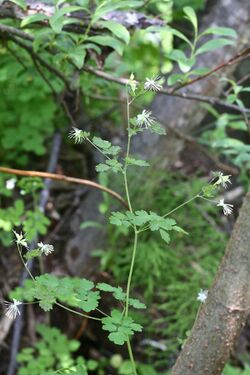Biology:Thalictrum sparsiflorum
| Thalictrum sparsiflorum | |
|---|---|

| |
| Thalictrum sparsiflorum - Amut lake. Solnechny District in Khabarovsk Krai, The Russian Far East | |
| Scientific classification | |
| Kingdom: | Plantae |
| Clade: | Tracheophytes |
| Clade: | Angiosperms |
| Clade: | Eudicots |
| Order: | Ranunculales |
| Family: | Ranunculaceae |
| Genus: | Thalictrum |
| Species: | T. sparsiflorum
|
| Binomial name | |
| Thalictrum sparsiflorum Turcz. ex Fisch. & C.A.Mey.
| |
Thalictrum sparsiflorum is a species of flowering plant in the buttercup family known by the common name fewflower meadow-rue.[1] It is native to northwestern North America and parts of northeastern Asia. It grows in moist habitat, such as streambanks and forest understory. It is a perennial herb producing erect stems up to about a meter in maximum height. The leaves have compound blades divided into a few or many segments which are borne on long, slender petioles. The blades are usually finely hairy and glandular. The inflorescence is a leafy panicle of flowers. Unlike some other Thalictrum species which are dioecious, this species has bisexual flowers. Each has a calyx of five greenish sepals, and up to 20 light-colored dangling stamens tipped with large anthers. The flowers develop into compressed, beaked fruits.
Unlike some Thalictrum species, it is pollinated by insects rather than wind.[2]
References
- ↑ "Thalictrum sparsiflorum". Natural Resources Conservation Service PLANTS Database. USDA. https://plants.usda.gov/core/profile?symbol=THSP. Retrieved 9 December 2015.
- ↑ Steven, Janet; Waller, Donald (2004). "Reproductive alternatives to insect pollination in four species of Thalictrum (Ranunculaceae)". Plant Species Biology 19 (2): 73–80. doi:10.1111/j.1442-1984.2004.00103.x. https://www.researchgate.net/publication/227512644_Reproductive_alternatives_to_insect_pollination_in_four_species_of_Thalictrum_Ranunculaceae. Retrieved 6 December 2018.
External links
Wikidata ☰ Q11079319 entry
 |

